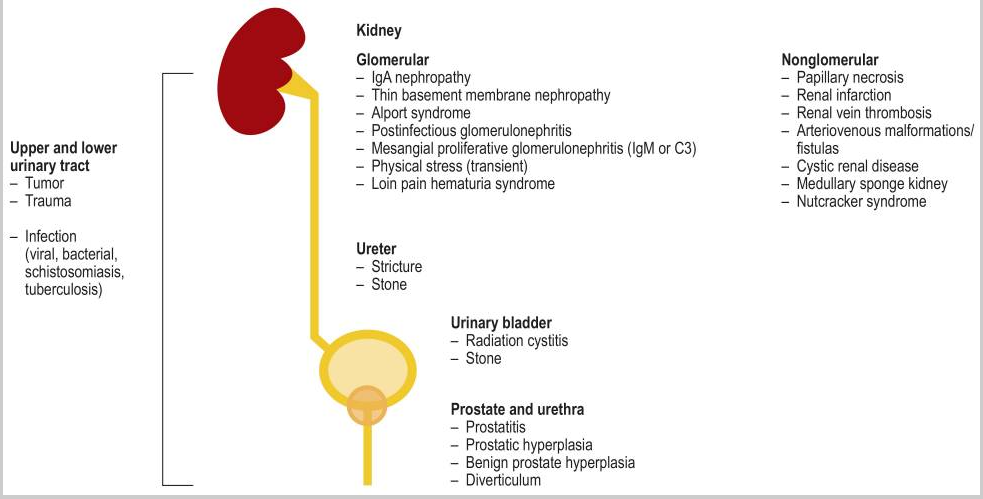Clinical Assessment
| Risk factors for developing urological cancer |
| Age >40 |
| Smoking |
| Exposure to occupational chemicals (benzenes, aniline dyes and aromatic amines) |
| Cyclophosphamide |
| Analgesic abuse |
| Prior pelvic irradiation |
| Recurrent UTI |
| Schistosomiasis infestation |
Haematuria may be painless and asymptomatic or painful. All patients with haematuria need rapid follow up and should be referred to 2 week wait urology clinics due to the risk of malignancy [6].

Medical history
In addition to a full past medical history, family history and genitourinary history, risk factors for urological cancer should be sought. These include age >40, smoking, exposure to occupational chemicals (benzenes, aniline dyes and aromatic amines), cyclophosphamide, prior pelvic irradiation, analgesic abuse, recurrent UTI and schistosomiasis infestation.
Learning bite
Risk factors are used to identify patients at increased risk of malignancy. Painless hematuria is more often due to neoplastic, hyperplastic, and vascular causes.
Timing
The timing in relation to the stream should be noted. Initial haematuria suggests a urethral source whereas terminal haematuria indicates a bladder neck or prostatic urethra source. Haematuria through the stream suggests bladder or upper tract pathology. Hematuria occurring between voiding and noticed only as staining of underclothes with blood, while voided urine is clear, indicates lesions at the distal urethra or the meatus. Prostatic bleeding is usually in the setting of a strong history of prostatic symptoms. Gross haematuria with clots represents significant bleeding and is a worrying sign of malignancy. Haematuria and colicky flank pain with stringy clots may suggest upper tract bleeding. Constant severe lower abdominal pain and haematuria may suggest clot retention. Large renal cell carcinomas can invade the renal pelvis and cause frank haematuria and clot colic.
Associated urinary symptoms
Full enquiry must be made of associated urinary symptoms. The most frequent scenario will be a female with history of frequency and dysuria who has microscopic haematuria in association with white cells and nitrites in the blood.
Systemic symptoms
Systemic symptoms and recent weight loss must be enquired for. A history of upper respiratory tract symptoms and possible streptococcal sore throat should be sought, to exclude post streptococcal glomerulonephritis and a consequent acute nephritic syndrome that can lead to long term renal problems [7,8]. Gastrointestinal symptoms may be a part of haemolytic uraemic syndrome and atrial fibrillation may result in renal emboli and haematuria. Sexual history, including recent coitus, must be noted as haematuria is common post coitally.
Learning bite
The acute nephritic syndrome is a feature of many systemic disorders and, in addition to haematuria, there is usually proteinuria with systemic symptoms. Hematuria that varies with menstruation and is associated with severe dysmenorrhea may indicate endometriosis involving the urinary tract.
Drug history
Drug history is important: penicillin, NSAIDS and cephalosporins can all cause interstitial nephritis [9]. Cyclophosphamide can cause haemorrhagic cystitis. Between 4 and 24% of patients on anticoagulants can develop haematuria [7]. They should be investigated in the same manner as those not on anticoagulants.
Physical examination
A full physical examination must be documented, paying particular attention to the presence of palpable bladder and masses per abdomen, rectally or pelvic. Close inspection of the vagina, including cervix, and male external genitalia should be performed. Vaginal bleeding must be excluded and this may require vaginal and speculum examination of the female patient. In such cases, careful inspection of the urethral area may reveal caruncles.
Specific rashes of conditions such as Henoch-Schonlein purpura and lupus should be sought.
